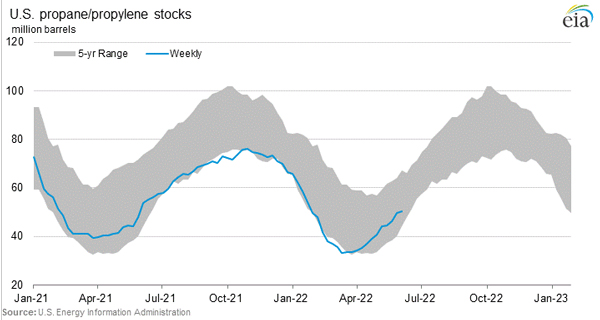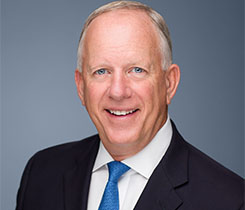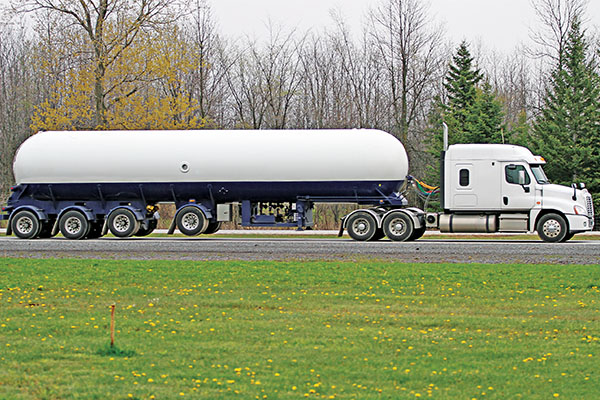DC discussions center on supply planning, storage and distribution strategies
We’re fresh off last week’s visit to Washington, D.C., for National Propane Gas Association (NPGA) meetings and Propane Days, the industry’s annual lobbying event. Here’s what we highlighted in our notes as it relates to the propane market, specifically on the topic of propane supply and distribution.
Even with soaring summer-like temperatures in parts of the country, Tucker Perkins, president and CEO of the Propane Education & Research Council (PERC), couldn’t help but remind industry members about the importance of securing winter supply.
His motivation stemmed from the latest U.S. Energy Information Administration propane inventory report, which revealed a build that was well below the five-year average and the industry’s expectations. For the week ending June 3, U.S. inventory stood at 50.2 million barrels, 3.4 million below the same week in 2021 and 2.3 million above the five-year minimum.
“It was a dismal report,” Perkins said June 8 during a propane marketers meeting in D.C. “We’re right back to the bottom of the five-year curve for available inventory.”
Perkins conflated inventory factors with developments on the corn crop side. The storyline in the agriculture market: Late planting in a wet season could potentially lead to more propane needed at harvest to dry the crop. The topic is relevant even to propane companies operating in low-demand ag states, Perkins added, because farmers could source propane from other states depending on their needs.
“If you look at the stats today, we’re setting up for something that hasn’t happened to us in a while, which is a pretty robust crop season,” he said.
Both NPGA and PERC offer tools and resources to help marketers track the progress of the corn crop and prepare for the harvest.
Site visits = propane education
At the same meeting, panelists from several propane companies discussed their experiences hosting site visits from legislators. It’s one tool that NPGA has been pushing in recent years to help promote more education about the industry.
Certainly, building relationships with policymakers can only help facilitate a better understanding of the industry, safeguard propane supply and open pathways to its distribution.
“Most legislators are not that familiar” with propane, said David Long of Greendale Propane Partners in Michigan, who joined Stephanie Hennen of Lakes Gas and Jim Rushing of Energy Distribution Partners on the panel.
Long explained how his team discussed the importance of the Line 5 pipeline with Rep. Lisa McClain, R-Mich., during her visit to one of the company’s facilities.
Line 5 is a light oil and natural gas liquids pipeline serving Michigan, the surrounding states and Canada. The state of Michigan has sought to close the pipeline, which travels in part under the Straits of Mackinac, to protect the Great Lakes from an oil spill.
“It was nice she stopped in to chat, to see what concerns we had,” Long said of McClain.
Site visits allow marketers to explain more about propane, he added, such as where it comes from and how it gets to the end user.
“I would recommend if any of you have the opportunity to host it’s well worth your while,” he said.
Strategic propane reserve?
Speaking of Michigan legislators, Democratic Sen. Debbie Stabenow looks to propose a federal bill that would require a study on the formation of a strategic propane reserve, explained Steve Kaminski, president and CEO of NPGA. A bipartisan group of U.S. senators proposed such a study following the challenging winter of 2013-14, but it never came to fruition.
This bill would likely begin a long, complex process, Kaminski added, but he first wanted to share about the renewed discussion.
Special exemption
NPGA leaders and members are discussing whether the industry should seek a special exemption from the Federal Motor Carrier Safety Administration (FMCSA) relating to emergency declarations and regional hours-of-service (HOS) waivers.
During the NPGA winter board of directors’ sessions, there was considerable discussion about the FMCSA regional emergency declaration that waived HOS requirements in response to winter demand and a reduction in workforce due to COVID-19 infections or exposures.
An idea stemming from those discussions was the potential value of a special exemption, which is an automatic waiver of specific regulations under certain circumstances for a period of five years. The topic resurfaced during NPGA meetings last week when Kaminski solicited additional feedback from members about proposed options. NPGA conducted a member survey in March and last week discussed sending a second survey to gain additional feedback before making a final decision on the course of action to take with FMCSA.
Speaking of HOS
In case you missed it, the FMCSA extended and amended its modified emergency declaration (No. 2020-002), related to the nationwide challenges and risks associated with COVID-19.
FMCSA’s extension and amendment, now through Aug. 31, provide HOS relief for commercial motor vehicle operations directly assisting in the support of emergency relief efforts. Propane, natural gas and heating oil are among the fuels listed in the declaration, which aims to address hampered supply chains.
Here’s more about the emergency declaration, including recommendations about it from NPGA.



















